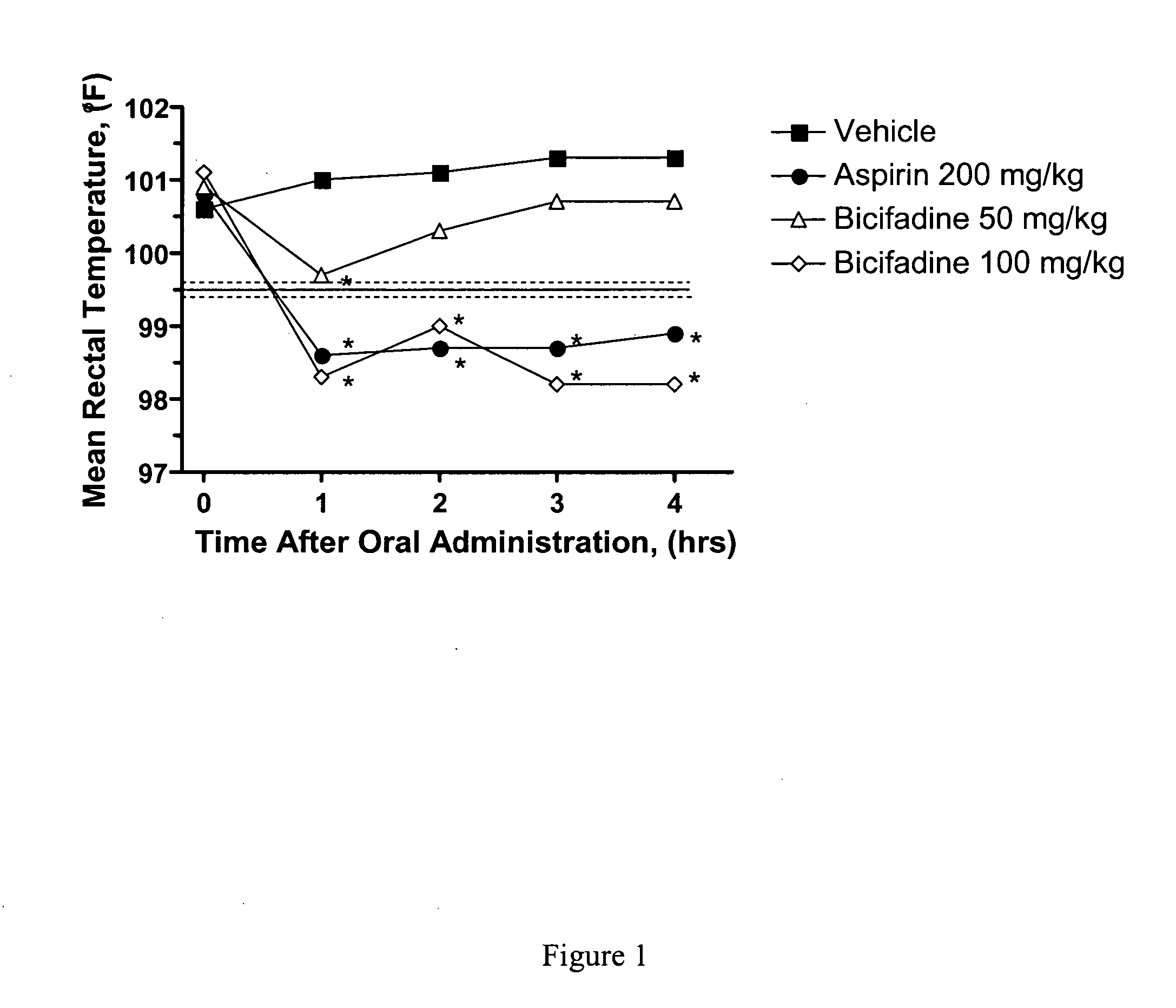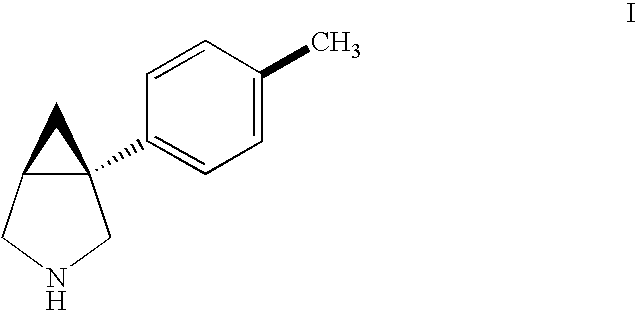Antipyretic compositions and methods
a composition and composition technology, applied in the field of antipyretic compositions and methods, can solve problems such as systemic damage, organ failure and even death, adverse sequelae, etc., and achieve the effects of attendant adverse conditions, preventing hyperthermia, and reducing the elevated body temperatur
- Summary
- Abstract
- Description
- Claims
- Application Information
AI Technical Summary
Benefits of technology
Problems solved by technology
Method used
Image
Examples
examples
[0070] Utilizing in vitro and in vivo analytical methods, it is demonstrated herein that bicifadine HCl ((±)-1-(4-methylphenyl)-3-azabicyclo[3.1.0]hexane hydrochloride, DOV 220,075) possesses significant antipyretic activity. This novel activity and use may be related to the ability of bicifadine to modulate noradrenergic and serotonergic neurotransmission by a combination of interactions with α1 and α2 adrenergic, and 5-HT2A receptors, as well as inhibition of norepinephrine re-uptake.
[0071] Insights into the potential mechanism by which bicifadine HCl expresses its antipyretic action were provided by biochemical assays (Table 5). While bicifadine HCl did not inhibit prostoglandin synthesis, it was capable of occupying binding sites on both the α1 and α2 adrenergic receptors. In addition, bicifadine HCl significantly inhibited radioligand binding to the 5-HT2A serotonin receptor. All three of these receptor subtypes are involved in thermoregulatory processes in the central and per...
example i
Preparation of 1-(p-tolyl)-3-azabicyclo[3.1 / 0]hexane hydrochloride
[0072] 230 ml of thionyl chloride was added to 120 g of p-tolylacetic acid and the solution was allowed to stand at room temperature for 2 hours, after which it was warmed to 60° C. for 1 hour. To this solution 285 g of N-bromosuccinimide and 10 drops of 48% hydrobromic acid were added and the mixture was refluxed on a 90° C. oil bath for 1 hour. An additional 90 ml of thionyl chloride was then added and refluxing continued for an additional 45 minutes. The resulting mixture was distilled under reduced pressure to remove 250 ml of thionyl chloride, and the residual liquid was poured into 500 ml of cold methanol with stirring and ice cooling over 15 minutes. This solution was evaporated under reduced pressure to give a dark oil which was then dissolved in 100 ml of chloroform. The solution was washed with 500 ml of water, dried over magnesium sulfate and filtered. The filtrate was evaporated under reduced pressure to ...
example ii
Preparation of (+)-1-(p-Tolyl)-3-azabicyclo[3.1.0]hexane hydrochloride
[0074] A solution of 94.8 g of racemic-1-(p-tolyl)-1,2-cyclopropanedicarboxylic acid and 73.8 g of (−)-α-(1-naphthyl)ethylamine in 300 ml of tetrahydrofuran was diluted with 300 ml of ethyl ether and was allowed to stand at room temperature until crystallization is complete. The mixture is filtered and the crystals which are collected were washed with cold tetrahydrofuran to give 4.95 g of a salt comprised of one molar equivalent of (+)-1-(p-tolyl)-1,2-cyclopropanedicarboxylic acid and one molar equivalent of (−)-α-(1-naphthyl)ethylamine. The salt was shaken with sodium hydroxide solution and ether. The aqueous phase was acidified with 12 N hydrochloric acid and the product was collected by filtration to give 26.0 g of (+)-1-(p-tolyl)-1,2-cyclopropanedicarboxylic acid as colorless crystals, [α]DCH3OH=+192°.
[0075] 15.0 g portion of (+)-1-(p-tolyl)-1,2-cyclopropanedicarboxylic acid, 6.6 g of urea and 500 ml of xyl...
PUM
| Property | Measurement | Unit |
|---|---|---|
| Temperature | aaaaa | aaaaa |
| Temperature | aaaaa | aaaaa |
| Mass | aaaaa | aaaaa |
Abstract
Description
Claims
Application Information
 Login to View More
Login to View More - R&D
- Intellectual Property
- Life Sciences
- Materials
- Tech Scout
- Unparalleled Data Quality
- Higher Quality Content
- 60% Fewer Hallucinations
Browse by: Latest US Patents, China's latest patents, Technical Efficacy Thesaurus, Application Domain, Technology Topic, Popular Technical Reports.
© 2025 PatSnap. All rights reserved.Legal|Privacy policy|Modern Slavery Act Transparency Statement|Sitemap|About US| Contact US: help@patsnap.com


